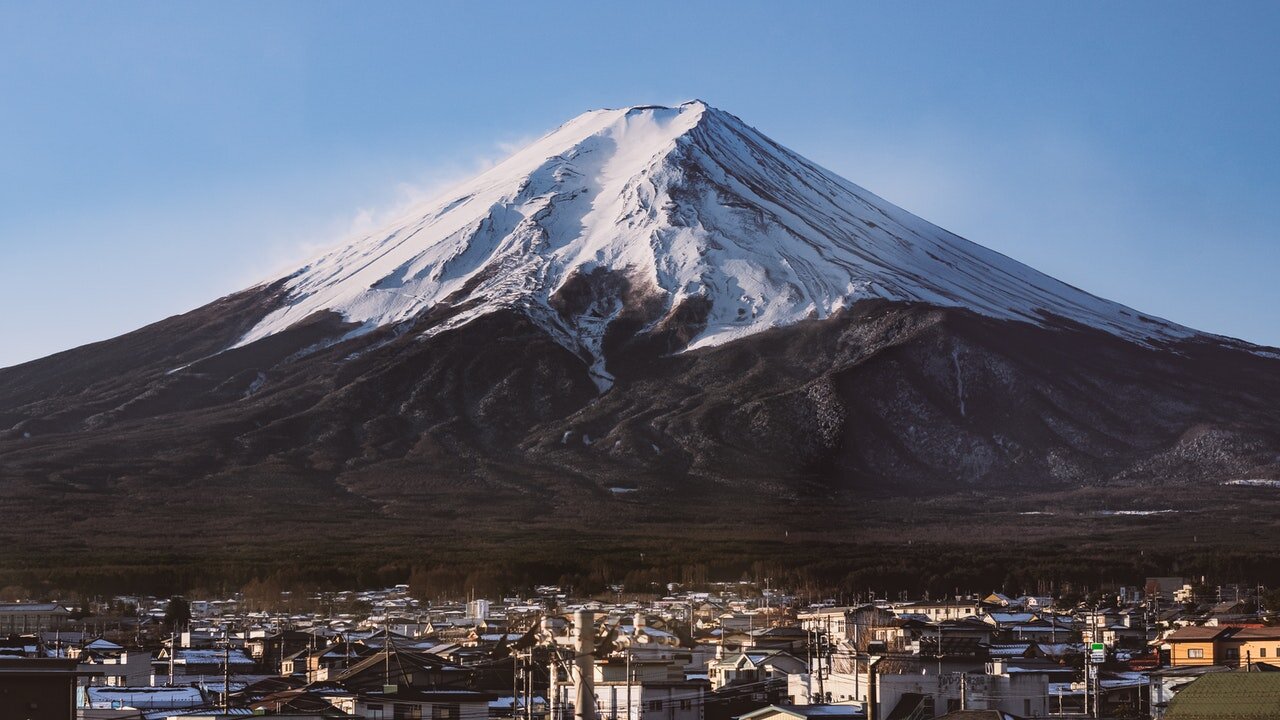Premium Only Content

Mount Fuji - scenic relaxation film with calming music
Mount Fuji - scenic relaxation film with calming music
Mount Fuji (富士山, Fujisan, Japanese: [ɸɯꜜ(d)ʑisaɴ] (listen)), or Fugaku, located on the island of Honshū, is the highest mountain in Japan, standing 3,776.24 m (12,389.2 ft). It is the second-highest volcano located on an island in Asia (after Mount Kerinci on the island of Sumatra), and seventh-highest peak of an island on Earth.[1] Mount Fuji is an active stratovolcano that last erupted from 1707 to 1708.[4][5] The mountain is located about 100 km (62 mi) southwest of Tokyo and is visible from there on clear days. Mount Fuji's exceptionally symmetrical cone, which is covered in snow for about five months of the year, is commonly used as a cultural icon of Japan and it is frequently depicted in art and photography, as well as visited by sightseers and climbers.[6]
Mount Fuji is one of Japan's "Three Holy Mountains" (三霊山, Sanreizan) along with Mount Tate and Mount Haku. It is a Special Place of Scenic Beauty and one of Japan's Historic Sites.[7] It was added to the World Heritage List as a Cultural Site on June 22, 2013.[7] According to UNESCO, Mount Fuji has "inspired artists and poets and been the object of pilgrimage for centuries". UNESCO recognizes 25 sites of cultural interest within the Mount Fuji locality. These 25 locations include the mountain and the Shinto shrine, Fujisan Hongū Sengen Taisha.[8]
History
Fine Wind, Clear Morning woodblock print by Hokusai, 19th century
Mount Fuji is an attractive volcanic cone and a frequent subject of Japanese art especially after 1600, when Edo (now Tokyo) became the capital and people saw the mountain while traveling on the Tōkaidō road. According to the historian H. Byron Earhart, "in medieval times it eventually came to be seen by Japanese as the “number one” mountain of the known world of the three countries of India, China, and Japan".[16] The mountain is mentioned in Japanese literature throughout the ages and is the subject of many poems.[17]
The summit has been thought of as sacred since ancient times and was forbidden to women until the Meiji era in the late 1860s. Ancient samurai used the base of the mountain as a remote training area, near the present-day town of Gotemba. The shōgun Minamoto no Yoritomo held yabusame archery contests in the area in the early Kamakura period.
The first ascent by a foreigner was by Sir Rutherford Alcock in September 1860, who ascended the mountain in 8 hours and descended in 3 hours.[18]: 427 Alcock's brief narrative in The Capital of the Tycoon was the first widely disseminated description of the mountain in the West.[18]: 421–27 Lady Fanny Parkes, the wife of British ambassador Sir Harry Parkes, was the first non-Japanese woman to ascend Mount Fuji in 1867.[19] Photographer Felix Beato climbed Mount Fuji two years later.[20]
On March 5, 1966, BOAC Flight 911, a Boeing 707, broke up in flight and crashed near the Mount Fuji Gotemba New fifth station, shortly after departure from Tokyo International Airport. All 113 passengers and 11 crew members died in the disaster, which was attributed to the extreme clear-air turbulence caused by lee waves downwind of the mountain. There is a memorial for the crash a short distance down from the Gotemba New fifth station.[21]
Today, Mount Fuji is an international destination for tourism and mountain climbing.[22][23] In the early 20th century, populist educator Frederick Starr's Chautauqua lectures about his several ascents of Mount Fuji—1913, 1919, and 1923—were widely known in America.[24] A well-known Japanese saying suggests that a wise person will climb Mt. Fuji once in their lifetime, but only a fool would climb it twice.[25][26] It remains a popular symbol in Japanese culture, including making numerous movie appearances,[27] inspiring the Infiniti logo,[28] and even appearing in medicine with the Mount Fuji sign.[29][30]
In September 2004, the manned weather station at the summit was closed after 72 years in operation. Observers monitored radar sweeps that detected typhoons and heavy rains. The station, which was the highest in Japan at 3,780 metres (12,402 ft), was replaced by a fully automated meteorological system.[31]
Mount Fuji was added to the World Heritage List as a Cultural Site on June 22, 2013.[7]
#mountfuji
#nature
#japan
#relax
-
 LIVE
LIVE
Melonie Mac
1 hour agoGo Boom Live Ep 36!
363 watching -
 1:02:11
1:02:11
Sarah Westall
1 hour agoFreezing USAID & its Operations in Ukraine: A Massive Money Laundering Organization? w/ Sam Anthony
7.47K1 -
 LIVE
LIVE
The StoneZONE with Roger Stone
1 hour agoRoger Stone Talks Trump’s Electric First 100 Day Agenda | The StoneZone w/ Roger Stone
443 watching -
 DVR
DVR
Redacted News
4 hours agoBREAKING! EPSTEIN LIST INCOMING UNDER AG PAM BONDI? DEMOCRATS FREAKING OUT, PRINCE ANDREW NERVOUS
130K159 -
 52:02
52:02
Candace Show Podcast
6 hours agoBecoming Brigitte: An Inaccessible Past | Ep 2
104K128 -
 LIVE
LIVE
2 MIKES LIVE
4 hours ago2 MIKES LIVE #176 News Breakdown Wednesday!
142 watching -
 LIVE
LIVE
I_Came_With_Fire_Podcast
5 hours agoGAZA TAKEOVER | USAID EXPLAINED | TARIFF TAKEDOWN
501 watching -
 37:14
37:14
The Based Mother
6 hours agoFULL OF IT! Crooked politicians say they care about children. Their actions tell a different story.
6.96K2 -
 1:54:12
1:54:12
Right Side Broadcasting Network
9 hours agoLIVE: President Trump Signs EOs; Pete Hegseth Meets with Netanyahu - 2/5/25
114K47 -
 1:51:41
1:51:41
Dr. Drew
7 hours agoPsychics Investigate DC Black Hawk & Philadelphia Medical Plane Crashes w/ Zach Vorhies + Eddie Conner & Andrew Anderson – Calling Out w/ Susan Pinsky – Ep 166
67.5K20